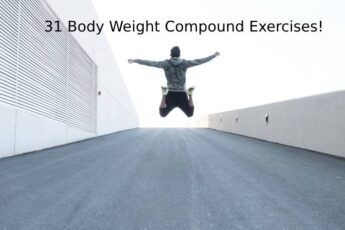Are you looking for effective workout exercises that you can do from the comfort of your own home? Look no further! In this article, we have compiled a list of 25 sweat-inducing exercises that will help you stay fit and healthy. Whether you are a beginner or an experienced fitness enthusiast, there is something for everyone.
From cardio workouts to strength training, these exercises target different muscle groups and can be easily modified to suit your fitness level. You don’t need any fancy equipment or a gym membership to get started. All you need is a desire to sweat it out and a small space in your home.
Not only will these exercises help you burn calories and build strength, but they will also improve your overall well-being. Regular physical activity has been shown to boost mood, reduce stress, and increase energy levels.
So, get ready to break a sweat and achieve your fitness goals from the comfort of your own home. Let’s dive in and discover the 25 effective workout exercises that will keep you fit and healthy.
Remember to consult with a healthcare professional before starting any new exercise routine.
The importance of staying active and fit
Staying active and fit is crucial for maintaining good health and overall well-being. Regular exercise not only helps you maintain a healthy weight, but it also reduces the risk of chronic diseases such as heart disease, diabetes, and certain types of cancer. Additionally, exercise improves your mental health by reducing stress, anxiety, and depression.
Exercise also boosts your energy levels and improves your sleep quality. When you engage in physical activity, your body releases endorphins, which are known as “feel-good” hormones. These endorphins not only elevate your mood but also increase your energy levels, making you feel more alert and focused throughout the day.
Benefits of working out at home
Working out at home has several advantages. Firstly, it saves you time and money. You don’t need to commute to the gym or pay for expensive memberships. You can exercise whenever it fits into your schedule, and you can do it in the comfort of your own home.
Secondly, working out at home provides privacy and convenience. Some people may feel self-conscious or intimidated when working out in a public gym. Exercising at home allows you to focus on your workout without any distractions or judgment. You can also customize your workout space according to your preferences and make it as comfortable as possible.
Lastly, working out at home allows you to be more flexible and creative with your exercises. You can choose from a variety of workout routines and modify them based on your fitness level and goals. You can also experiment with different equipment or workout videos to keep your routine interesting and challenging.
Setting up your home workout space
Before you start your home workout routine, it’s important to set up a dedicated space for exercise. You don’t need a lot of space, just enough room to move around comfortably. Clear any obstacles or clutter that may hinder your movements.
Choose a well-ventilated area with good lighting. Natural light is ideal, but if that’s not possible, make sure you have sufficient artificial lighting. A room with a mirror can also be beneficial, as it allows you to check your form and technique.
Invest in a few basic fitness equipment, such as dumbbells, resistance bands, and a yoga mat. These versatile tools can enhance your workouts and add variety to your routine. If you don’t have access to equipment, don’t worry! There are plenty of exercises that can be done using just your body weight.
Warm-up exercises to prepare your body
Before diving into your workout, it’s essential to warm up your body to prevent injuries and prepare your muscles for the upcoming activity. A proper warm-up increases your heart rate, improves blood flow to your muscles, and enhances your joint mobility.
Start with some dynamic stretching exercises, such as arm circles, leg swings, and torso twists. These movements help loosen up your muscles and increase your range of motion. Follow this with a few minutes of light aerobic activity, such as jogging in place or jumping jacks. This will further elevate your heart rate and warm up your entire body.
Cardiovascular exercises are essential for improving your heart health, burning calories, and increasing your stamina. They also help reduce the risk of chronic diseases and promote weight loss.
Here are a few effective cardiovascular exercises that you can do at home:
1. Jumping rope: Jumping rope is a high-intensity exercise that targets your legs, core, and cardiovascular system. Start with shorter intervals and gradually increase the duration as your fitness level improves.
2. Burpees: Burpees are a full-body exercise that involves a combination of squats, push-ups, and jumps. They are excellent for increasing your heart rate and burning calories.
3. High knees: Stand in place and lift your knees as high as possible while running in place. This exercise engages your core, glutes, and legs while providing a cardiovascular challenge.
4. Mountain climbers: Start in a plank position and bring one knee towards your chest, then quickly switch legs. This exercise targets your core, shoulders, and legs while giving you a cardio boost.
Remember to start slowly and gradually increase the intensity and duration of your cardiovascular exercises. Aim for at least 150 minutes of moderate-intensity cardio or 75 minutes of vigorous-intensity cardio per week.
Strength training exercises to build muscle
Strength training exercises are crucial for building lean muscle mass, improving bone density, and boosting your metabolism. They also help enhance your overall strength and functional abilities.
Here are a few effective strength training exercises that you can do at home:
1. Push-ups: Push-ups are a classic exercise that targets your chest, shoulders, triceps, and core. Start with modified push-ups on your knees and gradually progress to full push-ups.
2. Squats: Squats are a compound exercise that targets multiple muscle groups, including your quadriceps, hamstrings, glutes, and core. Focus on maintaining proper form and gradually increase the depth and intensity of your squats.
3. Lunges: Lunges target your quadriceps, hamstrings, glutes, and calves. Start with forward lunges and progress to reverse lunges and lateral lunges for added variety.
4. Plank: The plank exercise engages your core, shoulders, and glutes. Start with a modified plank on your knees and gradually progress to a full plank on your toes.
Remember to perform each exercise with proper form and technique. Start with lighter weights or no weights at all, and gradually increase the resistance as you get stronger. Aim for 2-3 strength training sessions per week, targeting all major muscle groups.
Core exercises for a strong and stable core
A strong core is essential for maintaining good posture, preventing lower back pain, and improving your overall stability and balance. Core exercises target the muscles in your abdomen, lower back, and pelvis.
Here are a few effective core exercises that you can do at home:
1. Plank variations: In addition to the standard plank, try different variations such as side planks, plank jacks, and plank twists. These exercises engage your entire core and challenge your stability.
2. Russian twists: Sit on the floor with your knees bent and feet lifted. Twist your torso from side to side while holding a weight or a water bottle. This exercise targets your obliques and improves rotational strength.
3. Bicycle crunches: Lie on your back with your hands behind your head and your legs in a tabletop position. Alternate bringing your opposite elbow towards your opposite knee while extending the other leg. This exercise targets your rectus abdominis and obliques.
4. Superman: Lie face down on the floor with your arms extended in front of you. Lift your arms, chest, and legs off the ground while squeezing your glutes. This exercise targets your lower back and glutes.
Remember to engage your core muscles throughout each exercise and breathe steadily. Start with a few repetitions of each exercise and gradually increase as you get stronger. Aim for 10-15 minutes of core exercises at least 2-3 times per week.
Flexibility exercises to improve mobility
Flexibility exercises are often overlooked but are essential for maintaining joint mobility, preventing injuries, and improving your overall range of motion. They also help reduce muscle soreness and promote quicker recovery.
Here are a few effective flexibility exercises that you can do at home:
1. Static stretching: Static stretches involve holding a position for 15-30 seconds without bouncing. Focus on stretching all major muscle groups, including your hamstrings, quadriceps, calves, chest, and shoulders.
2. Yoga: Yoga is a great way to improve flexibility, strength, and balance. There are plenty of online yoga classes and resources available for all levels, from beginners to advanced practitioners.
3. Foam rolling: Foam rolling is a self-massage technique that helps release muscle tension and improve flexibility. Roll different areas of your body, such as your calves, thighs, and back, using a foam roller.
Remember to warm up your muscles before performing flexibility exercises to prevent injuries. Aim for 10-15 minutes of flexibility exercises at least 2-3 times per week.
High-intensity interval training (HIIT) is a popular workout method that involves short bursts of intense exercise followed by brief recovery periods. HIIT workouts are effective for burning calories, improving cardiovascular fitness, and boosting your metabolism.
Here’s a sample HIIT workout that you can do at home:
1. Jumping jacks: Perform jumping jacks at a high intensity for 30 seconds, followed by a 15-second rest.
2. Squat jumps: Perform squat jumps for 30 seconds, followed by a 15-second rest.
3. High knees: Perform high knees for 30 seconds, followed by a 15-second rest.
4. Mountain climbers: Perform mountain climbers for 30 seconds, followed by a 15-second rest.
Repeat this circuit 4-5 times for a total workout time of 20-25 minutes. Remember to perform each exercise with maximum effort during the high-intensity intervals and use the recovery periods to catch your breath.
Cool-down exercises to promote recovery and reduce muscle soreness
After an intense workout, it’s crucial to cool down and allow your body to recover. Cool-down exercises help lower your heart rate, improve blood circulation, and reduce muscle soreness.
Here are a few effective cool-down exercises that you can do at home:
1. Walking or light jogging: Walk or lightly jog in place for 5-10 minutes to gradually lower your heart rate.
2. Static stretching: Perform static stretches for all major muscle groups, holding each stretch for 15-30 seconds without bouncing.
3. Foam rolling: Use a foam roller to roll different areas of your body, focusing on any tight or sore muscles.
Remember to listen to your body and adjust the intensity and duration of your cool-down exercises based on how you feel. Aim for 5-10 minutes of cool-down exercises at the end of each workout session.
In conclusion, staying fit and healthy doesn’t require a gym membership or expensive equipment. With these 25 effective workout exercises that you can do at home, you can break a sweat, burn calories, and achieve your fitness goals. Remember to consult with a healthcare professional before starting any new exercise routine, especially if you have any underlying health conditions. So, get ready to sweat it out and embrace the benefits of working out from the comfort of your own home.
Local Trainer US


